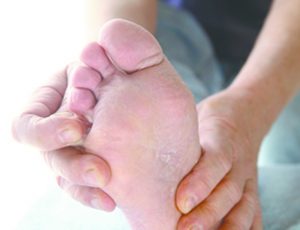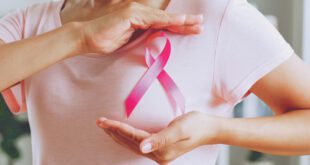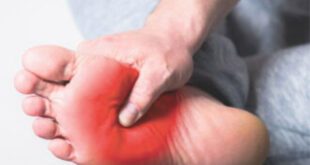Dr. John Bidelspach
 Athlete’s foot is a common, fungal skin infection we see in our patients. A majority of cases begin between the toes and spread to the bottom of the feet.
Athlete’s foot is a common, fungal skin infection we see in our patients. A majority of cases begin between the toes and spread to the bottom of the feet.
Athlete’s foot is caused from fungus growing on the top layer of your skin. It is contagious and you can get it from touching the affected area of a person who has it, and more commonly, from contaminated surfaces such as damp floors in public showers or locker rooms.
Anyone can get athlete’s foot, but it is more severe for a diabetic. Naturally, patients with diabetes have a weaker circulatory system along with an impaired immune system. This causes a higher risk for infection. Athlete’s foot is a concern for diabetics because their skin lacks hydration, making dry skin prominent.
Many diabetics confuse athlete’s foot as being dry
skin on their feet. Because athlete’s foot has similar characteristics to dry skin such as peeling, cracking redness, blisters, breakdown of the skin, itching and burning, it is understandable as to why these two conditions can be confused. If untreated, athlete’s foot can lead to a severe bacterial infection of the foot and leg.
Risk Factors
• Men are more susceptible than women
• Having athlete’s foot before
• An impaired immune system
• Living in a warm, damp climate
• More common in adults than children
Depending on the severity of the fungus, athlete’s foot can lead to blisters, cracked skin and open wounds. With a diabetic foot, a wound as minor as a blister can cause a lot of damage. Diabetes decreases blood flow, which causes healing time for injuries to be slower.
Diabetes also enables infections to spread quickly, which is a concern as it is one of the most common complications of the diabetic foot. If an infection becomes too severe there can be extreme consequences, even as far as amputation.
Tips for Treating a Diabetic Wound
1. Take care of the wound immediately. Even a minor wound as small as a blister or cut can become infected if bacteria are allowed time to build up after injury.
2. Clean your wound. Only use water to get the dirt out and then apply antibiotic ointment to prevent infection and cover with a sterile bandage. Don’t use soap, hydrogen peroxide or iodine as these can irritate the injury.
3. Keep pressure off wound. If your wound is on the bottom of your foot, stay off of it as much as possible.
4. See your podiatrist. Don’t risk an infection, see your doctor for minor skin problems or areas of interest before they become severe.
Prevent Athlete’s Foot from Occurring
You CAN prevent athlete’s foot from happening. A major prevention tip is to keep your feet dry and examine them each day. Fungus thrives in warm, damp areas.
Also, wear shoes or sandals that allow your feet to breath. Having a tight fit prevents moisture from escaping and creates an opportune place for fungus to live. It will also help to stay away from cotton socks! Cotton socks actually ABSORB your sweat and are slow to dry. If you wear cotton socks and don’t change them at least twice a day you can provoke blisters and provide a moist area for fungi to grow.
Bamboo socks are a great, eco-friendly alternative. Bamboo socks are woven from bamboo viscose fibers, which help pull moisture away from your feet. They also feel soft against the skin, repel odors and contain antibacterial prosperities!
If you happen to get athlete’s foot, good news is that it is treatable. Antifungal medicines are used on the skin as a first choice of treatment. These can be provided in prescription and nonprescription forms. If your case is severe enough, your doctor may prescribe oral antifungals. When treating athlete’s foot, it is critical that you use the full course of the medicine. If you stop taking the treatment because you see an improvement, there is a chance the fungi will return.
While patients with athlete’s foot are more prone to contracting it again, if you follow the preventative steps of cleaning your feet, making sure they are dry and checking your feet daily, your chances will decrease. You should also integrate a natural skin care line into your daily regimen that has both antifungal and antibacterial properties, like Doc Kelly’s Apothecary creams and soaps.
Consult your podiatrist if you see any warning signs. If you are diabetic, be sure to have yearly check ups with your podiatrist to ensure the health and safety of your feet.
Dr. John Bidelspach
Dr. B graduated from the Ohio College of Podiatric Medicine in 1990. He completed his residency in California at the Loma Linda Foot Clinic. He is licensed in both Florida & Georgia and has been in private practice since he moved to Florida in 1993.
Dr. B will be utilizing the same business model of the NLFC’s practice and incorporating his own style as well. The practice will be renamed to “Coast2Coast Podiatry Group”. Together the two of them have 50 years of Podiatry experience.
Coast 2 Coast Podiatry Group
The Villages Main Office: (Just West of Rolling Acres)
Heart Rhythm Associates, 781 HWY 466
Lady Lake, FL 32159
(888) 505-0592
www.coast2coastpodiatrygroup.com
Tags featured
Check Also
Revolutionizing Neuropathy Treatment: The Summus Laser Approach at LaserLab
Neuropathy, a condition affecting an estimated 42.5 million Americans, can significantly impact one’s quality of …
 Central Florida Health and Wellness Magazine Health and Wellness Articles of the Villages
Central Florida Health and Wellness Magazine Health and Wellness Articles of the Villages



